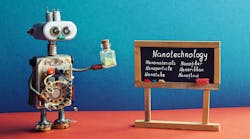Nanotech + IoT Brings Exciting Possibilities
A major takeaway from COVID-19 is that the total upheaval in every aspect of life and business means that going forward, we must learn to question every assumption we’ve made about everything. Just because we’ve done something some way in the past, from public health to business, doesn’t mean we’ll be able to, or should, in the future.
So what’s that got to do with manufacturing? The other day something popped into my head: What if, in this period of turmoil, the Internet of Things was to combine with another of my favorite innovations, nanotechnology?
Nanotech, if you’re not familiar with the term, refers to manufacturing things basically atom by atom so that materials’ structures can achieve specific properties impossible with traditional subtractive manufacturing processes. Its name is derived from items as small as several hundred nanometers. A nanometer is one one-billionth of a meter—a strand of human DNA is about
One IoNT innovation is ideally suited to facilitating the rapid transition to remote medicine due to COVID that I detailed in my last column. National University of Singapore (NUS) researchers recently invented clothing made of fabric with an extra layer of “metamaterials. The materials create “surface waves” wirelessly circling the wearer, making it possible to keep the energy of the signals created close to the body instead of spreading widely, so it uses less power and detects weaker signals. Because the signal to transmit real-time data about the wearer’s body is 1,000 times stronger than with conventional technologies, the batteries can be smaller and last longer. This would allow a doctor who accesses the data remotely during a telehealth call to make more accurate diagnoses. Relatedly, other researchers are developing IoNT “body sensor networks” that can gather and aggregate data from a variety of sensors placed on the body.
The IoNT could also have important benefits for our other greatest current challenge, global warming. In fact, global warming and the pandemic are likely linked: respected researchers believe that actions such as clearcutting rainforests may not only increase global warming, but also force wildlife that might be the source of future pandemics to leave their habitats—another reason to try to reduce environmental impacts. In part, small, low-powered sensors could be placed everywhere to monitor signs of global warming and other environmental dangers.
In addition, the sheer fact that IoNT devices are so small—requiring a bare minimum of raw materials to manufacture—and so efficient—only needing a small amount of electricity to power them—would make them an important way of reducing demands on the planet’s resources and minimizing power grid demands.
The “new normal” creates unprecedented risks to every aspect of our lives and business. As breakthroughs such as the Internet of Nanotech Things illustrate, those who seize the opportunity offered by the breakdown of conventional thinking can create new approaches that are not only profitable, but will also address these dangers.
W. David Stephenson, principal of Stephenson Strategies (Millis, Massachusetts), is an IoT consultant and thought leader. His The Future Is Smart (HarperCollins Leadership), was one of the first books on IoT strategy.




